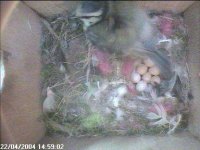I have a b/w camera with infra red lighting in a nest box in my garden, which is currently occupied and keeping me glued to the TV screen! The image is very bright though, so I think the lighting is probably too strong (there are 6 i/r leds in the camera unit). Does anyone have any suggestions as to the best way of reducing the light? I thought of masking off a couple of the leds but haven't tried anything yet. Has anyone had similar problems?
I'm certainly not going to change anything now the nest box is occupied but want to try something for next season.
I'm certainly not going to change anything now the nest box is occupied but want to try something for next season.





